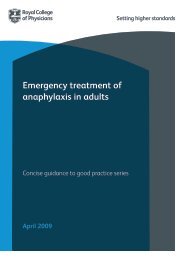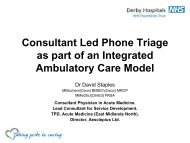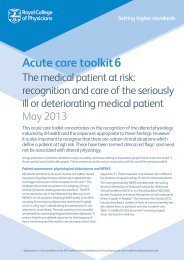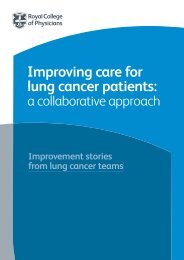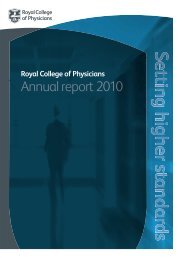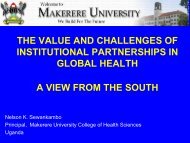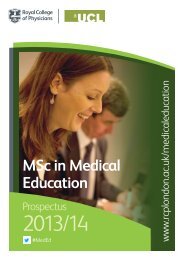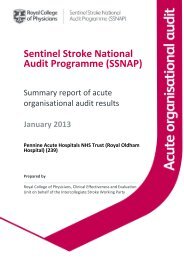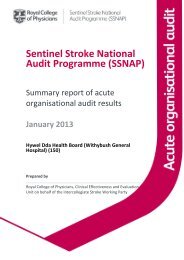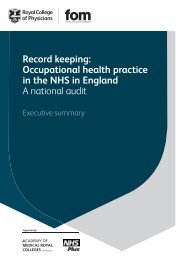Consultant physicians working with patients - Royal College of ...
Consultant physicians working with patients - Royal College of ...
Consultant physicians working with patients - Royal College of ...
You also want an ePaper? Increase the reach of your titles
YUMPU automatically turns print PDFs into web optimized ePapers that Google loves.
2 Specialties Medical ophthalmologyWorking <strong>with</strong> other specialtiesOphthalmic <strong>physicians</strong> work closely <strong>with</strong> otherspecialties, although the specialties vary depending onthe areas covered. The following list is not exhaustivebut shows the variety <strong>of</strong> specialties that interact <strong>with</strong>medical ophthalmology: ocular and orbital inflammation – rheumatology,renal medicine, respiratory medicine,endocrinology, dermatology, infectious diseases,microbiology, haematology and radiology neuro-ophthalmology – neurology, neurosurgery,endocrinology, stroke, rehabilitation medicine andradiology diabetic eye disease – diabetes, renal medicine andobstetrics medical retina – clinical genetics and stroke.Working <strong>with</strong> community servicesThe traditional organisational boundaries <strong>of</strong> primaryand secondary care are becoming blurred 7 and this isparticularly true for ophthalmic practice <strong>with</strong> thegrowing role <strong>of</strong> community-based optometry services.Chronic disease management (eg diabetes) andprevention <strong>of</strong> disease (eg smoking cessation) arecommonly organised through general practice.Increasingly, optometrists are taking on extended rolesand being trained to diagnose and manage specificanterior segment eye conditions and glaucoma.Effective communication between different communityservices and between hospital and community servicesis vital to ensure that <strong>patients</strong> are referred in a timelyand appropriate fashion.Ophthalmology departments work <strong>with</strong> local socialwork departments and societies for the visuallyimpaired to ensure that <strong>patients</strong> <strong>with</strong> sight loss are ableto live as independently as possible. Eye clinic liaison<strong>of</strong>ficers exist in some centres to provide information,emotional support and advice to <strong>patients</strong> and cruciallyact as a link between the eye clinic, rehabilitationservices (such as low vision aid assessments) andsupport services in the community for <strong>patients</strong> <strong>with</strong>visual impairment.5 Delivering a high-quality serviceWhat is a high-quality service?A high-quality medical ophthalmology service is onethat bridges the gap between hospital ophthalmicservices, medical care and community-based care, usingresources efficiently and effectively to provide acoordinated, patient-centred service for those <strong>with</strong>medical ophthalmic problems.Effective communication <strong>with</strong> <strong>patients</strong> and theirfamilies and between ophthalmic <strong>physicians</strong> and otherhealth pr<strong>of</strong>essionals involved, including those incommunity services, is essential.Quality <strong>of</strong> services should be monitored andophthalmic <strong>physicians</strong> should audit the performance <strong>of</strong>their services regularly, eg recording complication ratesfrom intravitreal injections and visual outcomes fortreated AMD.Ophthalmic <strong>physicians</strong> have a responsibility to train notonly doctors and trainee doctors but also members <strong>of</strong>the wider team, which may include nurses, optometristsand orthoptists. They have a leadership role <strong>with</strong>in thehospital eye service and may choose to take on othermanagement responsibilities or roles <strong>with</strong>in theNational Health Service (NHS), deanery, university orcollege.Ophthalmic <strong>physicians</strong> should manage their owncontinuing pr<strong>of</strong>essional development (CPD) and have aresponsibility to maintain their knowledge and skills, topractise safety and to keep up to date <strong>with</strong> newdevelopments. They should recognise their limitationsand work <strong>with</strong>in their capabilities, referring <strong>patients</strong> onor seeking advice where appropriate.Societies and collegesThe Medical Ophthamological Society UK is thepr<strong>of</strong>essional society for ophthalmic <strong>physicians</strong>(www.mosuk.co.uk). The <strong>Royal</strong> <strong>College</strong> <strong>of</strong>Ophthalmologists (www.rcophth.ac.uk)isthepr<strong>of</strong>essional body for ophthalmologists, which includesophthalmic <strong>physicians</strong>, and has a role in trainingdelivery, manpower planning and other pr<strong>of</strong>essionalissues. The Joint <strong>Royal</strong> <strong>College</strong>s <strong>of</strong> Physicians TrainingBoard (JRCPTB) runs the medical ophthalmologytraining programme, 8 <strong>with</strong> input from the <strong>Royal</strong><strong>College</strong> <strong>of</strong> Ophthalmologists. Trainees in medicalophthalmology enter specialty training (ST) at ST3 levelfrom either core medical training or ophthalmologytraining.GuidelinesThe following guidelines are relevant to medicalophthalmology:C○ <strong>Royal</strong> <strong>College</strong> <strong>of</strong> Physicians 2013 163



